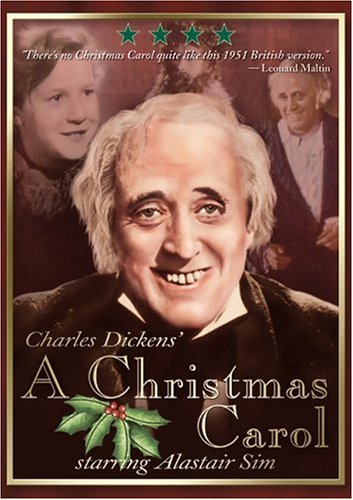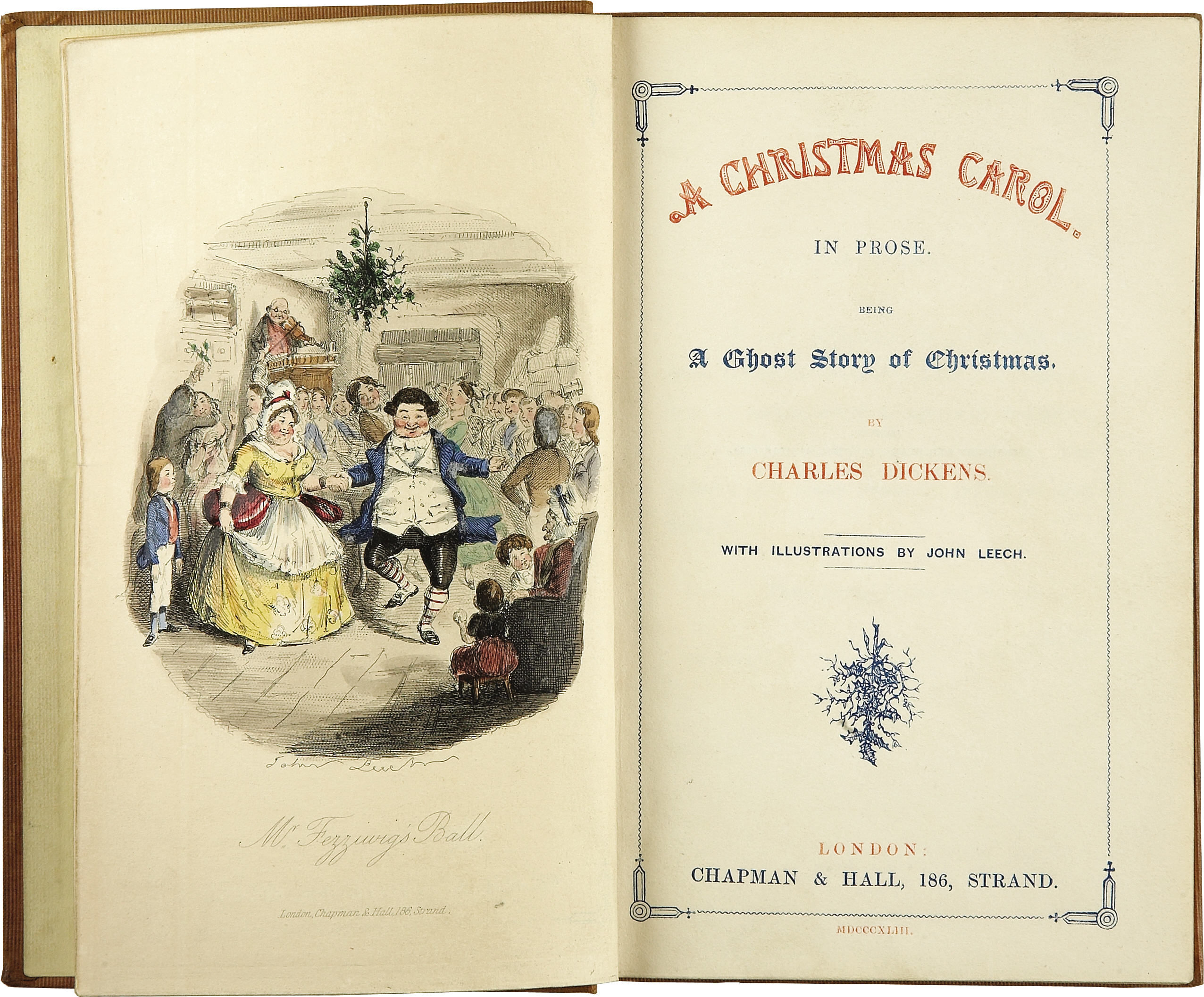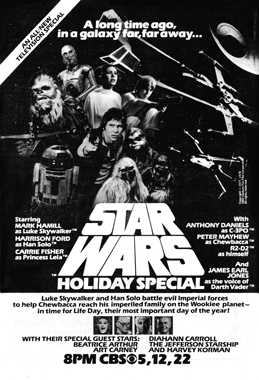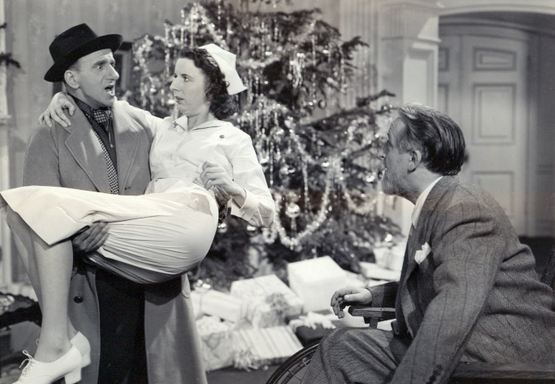Marley was dead to begin with. There is no doubt whatever about that. The register of his burial was signed by the clergyman, the clerk, the undertaker, and the chief mourner. Scrooge signed it. And Scrooge's name was good upon 'Change, for anything he chose to put his hand to. Old Marley was as dead as a door-nail.So begins one of the most popular and long-lived novellas in English literature.
 |
| A Christmas Carol, front piece and title page (1843) |
If you have read biographies of Dickens, or if you perhaps had the good fortune to catch Roy Dotrice’s 13 part 1976 Masterpiece Theatre presentation chronicling the life of Dickens, you already know that many of the characters in A Christmas Carol were drawn from Dickens’ own life. Characteristics of Ebenezer Scrooge were taken in broad brush from Dickens' father, a man whose moods swung often from joy to darker visages, who was in and out of debtors prison, and with whom Charles Dickens had a life-long love/hate relationship. Fan, Scrooge’s fragile sister, bears the same name as Dickens’ equally fragile sister, and her son Henry, a sickly child who died young, is almost certainly the model for Tiny Tim. Fred, Scrooge’s nephew, is also the name of Dickens’ younger brother, a spendthrift of whom Dickens largely disapproved.
There is also evidence that both the story and the theme of A Christmas Carol had haunted Dickens for years before he actually sat down to write the novella. In fact, a “working draft” of A Christmas Carol can be found buried in another Dickens story, a short narrative of Christmas redemption that appears in the earlier novel Pickwick Papers. There, in an episode that also transpires on Christmas Eve, the character Mr. Wardle tells those assembled the story of old Gabriel Grub, a lonely and bitter sexton, who undergoes a Christmas conversion after being visited by goblins that show him scenes from his own past and, unless things change, his likely future.

While all of this is useful background information, The Annotated Christmas Carol by Charles Michael Hearn (2004) notes that the catalyst that inspired Dickens to write A Christmas Carol was his visits in early 1843 to Cornish tin mines. During those visits the author encountered child laborers working in deplorable and heart-wrenching conditions. After touring the mines Dickens immediately set to work on a pamphlet that was to be titled "An Appeal to the People of England, on behalf of the Poor Man's Child," and that was intended as a clarion call to end child labor, particularly in the mines. Charles Kelly, in his 2003 treatise A Christmas Carol, reports that Dickens soon concluded, however, that his call for labor reforms and charity for the poor would be more resoundingly received if they were set forth during the course of a story, particularly one cloaked in the setting of a London Christmas.
| A page of Dickens original manuscript |
Although expenses related to Dickens’ decision to self-publish (tricky then as it can be now) resulted in less of a return than the always over extended author had hoped for, the little book was nonetheless an immediate commercial success. The first run of 6000 copies sold out by Christmas Eve of 1843 and a second press run was immediately begun . Since then Dickens’ A Christmas Carol has never been out of print.
The success of A Christmas Carol inspired Dickens to write four additional Christmas tomes published between 1844 and 1848: The Chimes, The Cricket on the Hearth, The Battle of Life, and The Haunted Man and the Ghost's Bargain. Each of these was published just before Christmas in succeeding years, and each involved a similar theme – redemption of the spirit in the context of the yuletide holiday. But none matched the success of A Christmas Carol.
So, what was it – what is it – about A Christmas Carol that struck the right chord? Well, at least back in 1843 some of the success of the book can be attributed to rather remarkable timing. Stated another way, the little book was a product of its times.
In the early 1800s Christmas had been more of a somber affair in England. It was a day barely observed, when businesses remained open and commerce continued to flow. That fact makes more understandable the grudging question Scrooge poses to Cratchitt: “You will want all day tomorrow, I suppose?” Scrooge, after all, had presided over his business in years when a Christmas holiday from commerce was hardly the norm.
But by the 1830s times were changing, and the Yule had begun its transformation into a joyous year-end celebration.
Evidence of this transformation abounds. In 1841, for example, Queen Victoria's husband Prince Albert, German by birth, introduced a tradition from his homeland and the first Christmas trees appeared in England. 1843, the year A Christmas Carol was published, is also the first year that Christmas cards were widely exchanged in England. The singing of Christmas carols, suppressed in England since the Protestant Reformation and the Calvinist aversion to "nonessential" religious customs, also enjoyed a resurgence in the 1830s as wassailing took hold in England. All of this was in place when A Christmas Carol first appeared in the bookstores of London in December of 1843.
Even meteorology cooperated with Dickens’ narrative. The “white Christmas” setting of A Christmas Carol was hardly the norm in London, which more typically receives 6 to 12 inches of snow spread over the entire winter season. But this was not so much the case during Dickens' lifetime. In his biography of Dickens, Peter Ackroyd wrote: "In view of the fact that Dickens can be said to have almost singlehandedly created the modern idea of Christmas, it is interesting to note that in fact during the first eight years of his life there was a white Christmas every year; so sometimes reality does actually exist before the idealized image." Probably even more telling was the fact that on Christmas Eve of 1836 – seven Christmases before the publication of A Christmas Carol, and the very night that Dickens tells us Jacob Marley lay dying – London was blanketed in a blizzard that continued for five days and reportedly left snow drifts of 12 to 40 feet in the city.
And beyond all of this is the moral of the story, which, as Dickens had hoped, captivated his readers. In 1843 England -- beset with its poor houses, debtors prisons, and child labor -- the hope of individual and societal redemption that lies at the heart of A Christmas Carol fell on sympathetic ears. Dickens was not the only Englishman appalled by these conditions, nor was he the only one hoping that society would begin to move toward a more charitable approach toward poverty and its ravages.
So a joyous Christmas story, set in a snow-bound England, and telling a tale of redemption, of throwing off miserly ways, of embracing human kindness and charity, was one that the reading public readily embraced.
It is more elusive, perhaps, to explain the amazing staying power of A Christmas Carol. It has proven itself, beyond all debate, to be a story not just for the Victorian age, but for all ages.
 |
| Alistair Simms -- perhaps the finest portrayal of Ebeneezer Scrooge |
I re-read Dickens A Christmas Carol often, and (at least for me) it always works.
Scrooge was better than his word. He did it all, and infinitely more; and to Tiny Tim, who did not die, he was a second father. He became as good a friend, as good a master, and as good a man, as the good old city knew, or any other good old city, town, or borough, in the good old world. Some people laughed to see the alteration in him, but he let them laugh, and little heeded them; for he was wise enough to know that nothing ever happened on this globe, for good, at which some people did not have their fill of laughter in the outset; and knowing that such as these would be blind anyway, he thought it quite as well that they should wrinkle up their eyes in grins, as have the malady in less attractive forms. His own heart laughed: and that was quite enough for him.
He had no further intercourse with Spirits, but lived upon the Total Abstinence Principle, ever afterwards; and it was always said of him, that he knew how to keep Christmas well, if any man alive possessed the knowledge. May that be truly said of us, and all of us! And so, as Tiny Tim observed, God Bless Us, Every One!



.jpg)
































